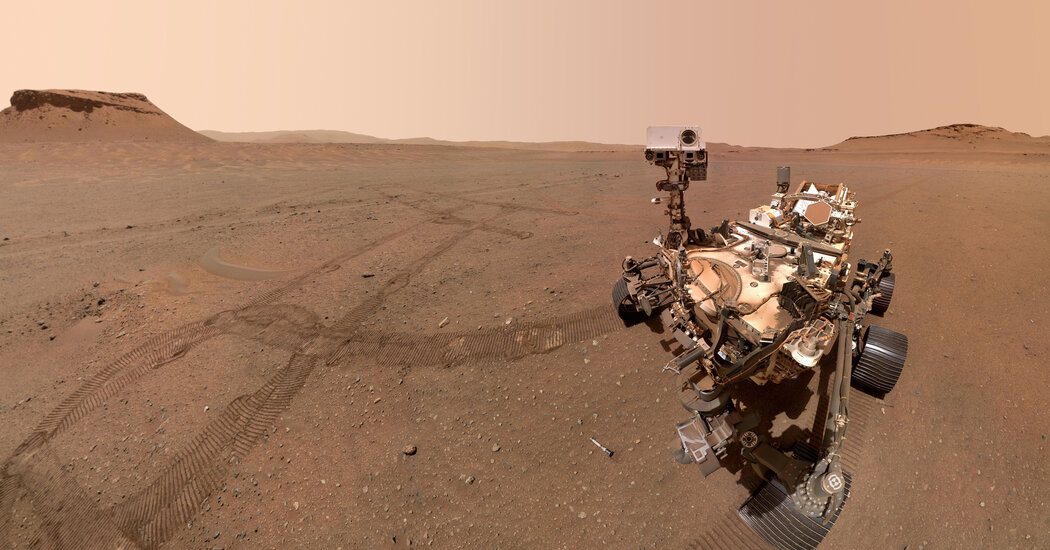NASA wants assist retrieving rocks from Mars, and on Tuesday, company officers introduced they nonetheless have not determined how to try this. As a substitute, they go away the ultimate resolution to the incoming administration of President-elect Donald J. Trump.
However officers mentioned they discovered learn how to probably launch the mission and return these crimson planet rocks again to Earth sooner by lowering the scale and weight of the mission, often known as Mars Pattern Return. Estimates for spending final yr rose to $11 billion. With the revisions, the Mars Pattern Return continues to be costly, however will price lower than $8 billion.
“It is a great distance from $11 billion,” NASA Administrator Invoice Nelson mentioned throughout a phone information convention Tuesday.
Bringing samples of Martian rock and soil again to Earth is among the many high priorities of planetary scientists. Whereas spacecraft in orbit and rovers on the floor of Mars have found a lot, their capabilities are restricted. By finding out contemporary rocks up shut with the most recent, strongest devices of their labs, scientists might unravel the mysteries of the crimson planet’s previous, together with probably whether life ever arose there.
The primary section of the return of samples from Mars is already underway. NASA’s Perseverance roverwhich landed on Mars in 2021 was drilling and collecting cylindrical rock and soil samples c The crater lakewhich comprises an historic river delta.
The remainder of the plan, developed by NASA’s Jet Propulsion Laboratory in California, requires complex choreography. First, a brand new robotic spacecraft will land close to the Perseverance rover, which can then ship about 30 of its rock samples for launch into orbit round Mars. One other spacecraft, from the European Area Company, will take these samples, carry them again to Earth and deposit them in a small disc-shaped automobile that may land in the Utah desert.
That plan stays primarily the identical, however the important thing to the change is the conclusion that the rocket to launch the samples from the floor of Mars into orbit across the planet doesn’t should be as giant and heavy as the unique design.
With a smaller rocket, NASA now not needed to construct a lander bigger than any it had ever made.
As a substitute, the mission might as soon as once more use the sky crane system that has efficiently deployed the Curiosity and Perseverance robotic rovers presently exploring Mars. The sky crane lowers the lander with the rocket by way of a cable from a suspended rocket stage.
NASA officers additionally left open the chance that as a substitute of the sky crane, the company might buy a lander from a industrial firm.
Mr. Nelson, who will step down as NASA administrator with the change of presidents mentioned later this month that NASA officers below Mr. Trump’s administration would doubtless be capable to decide someday subsequent yr.
“What we needed to do was give them the very best choices to get out of right here,” Mr Nelson mentioned.
Nonetheless, he additionally mentioned that to maintain this system from being delayed additional, Congress would wish to supply not less than $300 million this yr.
Like a lot of NASA’s most bold initiatives, Mars Pattern Return goals to do one thing that is by no means been finished earlier than, and that makes it exhausting to foretell how troublesome and costly it is going to be.
Initially, the 2 spacecraft wanted for the mission — the lander constructed by NASA and an orbiter constructed by the European Area Company to return the rocks — have been initially scheduled to launch in 2026, and NASA’s share of the price can be $3 billion. greenback.
Unbiased Assessment in 2020 concludes that the 2028 launch date is extra practical and the value will likely be between 3.8 and 4.4 billion {dollars}. Second assessment in 2023. discovered these predictions to be too optimistic. Instead, NASA’s share of the mission will be $8 billion to $11 billionmentioned the panel. And company officers concluded that the rocks wouldn’t be delivered to Earth earlier than 2040.
“We turned it off,” Mr. Nelson mentioned.
NASA then sought different concepts from aerospace firms in addition to specialists on the house company, ranging from scratch on a model new mission or suggesting higher methods to execute a specific half of the present plan.
A group inside NASA evaluated the choices and got here up with adjustments which might be extra revisions than a whole overhaul.
“We’re actually enthusiastic about it,” mentioned Nicola Fox, affiliate administrator for NASA’s Science Mission Directorate. “As all the time, my precedence is to discover a approach ahead for the return of our samples inside a balanced total science program in order that NASA’s science continues to ship.”
One spacecraft could possibly be launched as early as 2030 and the opposite in 2031, Dr. Fox mentioned.
Different adjustments embrace switching from photo voltaic panels to a radioactive warmth supply to supply energy and simplifying the system for transferring rock samples from Perseverance to the rocket that may launch them into house.
After NASA introduced it was in search of new concepts, the Jet Propulsion Laboratory slowed work on the Mars Pattern Return and final February laid off greater than 500 staff, or about 8 % of the workforce.
NASA officers haven’t mentioned the main points of any of the industrial choices. For the reason that preliminary proposals, NASA has commissioned research from eight firms, which embrace house giants like Lockheed Martin, in addition to two newer rocket firms run by billionaires – Elon Musk’s SpaceX and Jeff Bezos’ Blue Origin.
Mr. Musk prioritized reaching Mars Starship, its next generation vehiclepromising to launch unmanned variations of that missile to that vacation spot 2026 at the earliest. Nonetheless, Starship stays below growth and has but to orbit Earth.

